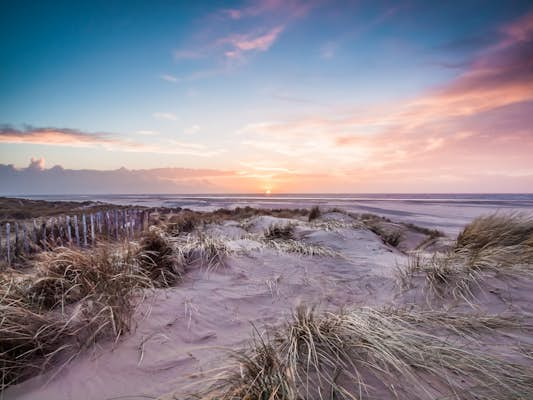From golden Cornish sands to rugged Scottish strands, visitors to the UK will never be short of epic coastlines to visit. And while they will never be as sun-kissed as their Mediterranean counterparts, the UK’s beaches come with bags of character, charm, and the occasional surprise.
So embrace the weather, take in the views and don’t forget to enjoy some fish and chips. Here are 11 of the best beaches across the United Kingdom to get you thinking about your next escape to the seaside.
Kynance Cove, Cornwall
A mile north of Lizard Point in Cornwall, the National Trust–owned inlet of Kynance Cove is a showstopper, studded with craggy offshore islands rising out of searingly blue seas that look almost tropical.
The cliffs around the cove are rich in serpentine, a red-green rock popular with Victorian trinket-makers. It’s an impossibly beautiful spot and, when the seas aren’t too rough, an exhilarating place for a wild swim. Drinks and snacks are available at the nearby beach cafe.

Luskentyre, South Harris, Scotland
Luskentyre in South Harris is one of the biggest and most beautiful beaches in Scotland, famed for its acres of low-tide white sands and turquoise waters with stunning views of snow-dusted mountains.
Along the northern side of the bay is a minor road where you can walk west along the beach or through the grassy dunes with gorgeous views across the sea to the island of Taransay. Just south of the beach is the charming little roadside Cake Shed – almost certainly Scotland’s smallest cafe.
Shell Beach, Herm, Guernsey
Herm’s star beach wouldn’t look out of place in the Caribbean, if it weren’t for the severe-looking bare rocks offshore. Teal waters lap at the wide expanse of blindingly white sand at Shell Beach. Sea kayaking is popular in the summer season.
Taking its name from the millions of tiny shell fragments washed in from the Gulf Stream, it’s located on the popular Herm Island to the east of Guernsey. Look out for the red and orange parasols of the Shell Beach Cafe when you need refreshments.

Gwithian and Godrevy Towans, Cornwall
These wonderful side-by-side beaches join up at low tide to form one epic stretch of golden, flat sand. At the eastern end is the small cove of Godrevy, with its island lighthouse (said to have inspired Virginia Woolf’s To The Lighthouse).
To the west lies Gwithian, a great sandy arc that extends to the Hayle River. The grassy cliffs (known in Cornish as towans) are an important wildlife habitat, carpeted with wildflowers in summer, and provide nesting sites for seabirds. Grab a warm coffee from the distinctive blue Hungry Horsebox Co mobile beach cafe.
Barafundle Bay, Pembrokeshire, Wales
Regularly voted one of Britain’s most beautiful beaches, Barafundle Bay in Pembrokeshire is a scenic 15-minute walk south along the coast path from Stackpole Quay and the excellent Boathouse Tea-room. It is a gorgeous spot but its reputation means that on summer weekends it can get pretty crowded despite its remote location. Arrive early, or you won’t be able to get a carpark.
Visit during the off-season and you may have the whole place to yourself.

Portstewart Strand, Northern Ireland
The broad 1.5-mile (2.5km) beach of Portstewart Strand in Northern Ireland is a pristine stretch of strand and an essential stop if you are driving the Causeway Coast. As well as views of Inishowen headland and Mussenden Temple perched on the cliffs above, the beach is also an important nature conservation site with way-marked trails.
Uniquely, parking is allowed on the firm sand, which can accommodate over 1000 cars, though you will need to pay for the privilege in high season. Sublime seafood from the beachfront Harry’s Shack is a must.
Sandwood Bay, Scotland
South of Cape Wrath, Sandwood Bay boasts one of Scotland’s best and most isolated beaches, guarded at one end by the spectacular rock pinnacle Am Buachaille. Sandwood House is a creepy ruin reputedly haunted by the ghost of a 16th-century shipwrecked sailor from the Spanish Armada.
Don’t expect any pubs or cafes in this distant corner of Scotland, though there’s no finer place if you just want to get away from it all for a while.
Wells Beach, Norfolk, England
Fringed by dense pine forests and undulating dunes, Wells‘ sandy shore in Norfolk stretches for miles to the west, with brightly colored beach huts clustering beside the water and wooden steps leading up into the woods.
It’s all tucked away at the end of a mile-long road; you can walk, drive or hop on a miniature train connecting the town, beach, and Pinewoods holiday park.

Three Cliffs Bay, Gower Peninsula, Wales
Three Cliffs Bay on the Gower Peninsula is named for the pyramid-like sea cliffs pierced by a natural arch jutting out into the water. One of the more spectacular beaches in Wales, it’s particularly impressive when viewed from the impossibly picturesque ruins of 13th-century Pennard Castle. Glinting below, the Pennard Pill stream empties into the bay, creating dangerous currents for swimmers at high tide. The craggy headland is a popular rock-climbing site, while the only way to reach the beach is on foot.
Traigh Mor, Barra, Scotland
This vast expanse of firm golden sand (the name means “Big Strand”) serves as Barra’s airport (a mile across at low tide, and big enough for three “runways”), the only airport in the world where scheduled flights use a tidal beach as the runway.
Watching the slightly jarring sight of the little Twin Otter aircraft come and go is a popular spectator sport. In between flights locals gather cockles – a local seafood specialty – from the sands.
